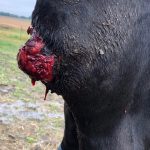Large animal wounds
Skin loss and exuberant granulation tissue
Poor epithelialization
The horse’s leg does not have much loose skin. A larger wound may not be able to completely epithelialize. If wounds stop contracting before healing is complete, a skin graft may be necessary. The most common forms of skin grafting are punch or pinch grafts, with donor skin being taken from the neck or ventral abdomen. Skin grafting does require strict immobilization to allow the skin plugs to attach and vascularize. Skin grafting in horses is meticulous and time consuming. It is best done in a hospital setting both for the surgery and the initial postoperative period.

Proud flesh (exuberant granulation tissue)
Granulation tissue provides new blood supply with nutrients and oxygen. Once granulation tissue fills the wound, infection from the environment is very low risk. Granulation tissue protects as well as nourishes the tissues. Granulation typically starts to appear about day 4-5 after wounding.
However, due to the poor oxygenation levels in the lower limb, horses tend to develop “exuberant” granulation tissue aka proud flesh. In these horses, the new granulation tissue grows more than it should (exuberantly?). Instead of just filling in the wound, exuberant granulation tissue grows above the level of the wound, preventing epithelialization. The proud flesh must be removed so that the new skin cells can cover the surface.
Proud flesh removal can be done with a laser, sharp blade or safety razor. The tissue does not have nerve endings so the process is not painful if the skin margins are not cut accidentally. However, it will bleed profusely.
Video – proud flesh treatment w/captions
After debridement of the proud flesh, a “bandaid” or short term wrap can be used to apply pressure to the surface. This should be removed after bleeding stops (or the following day) to minimize the risk of more granulation tissue. After removal of the bandage, a light layer of corticosteroid ointment can be applied.
Owners can be taught to recognize the early signs of proud flesh and shown how to trim it back with a safety razor.
Proud flesh can be managed with a variety of products; however, most products also damage epithelial cells. Hydrocortisone applied topically and weekly can control proud flesh with minimal effect on new epithelialization.
Once the wound has filled in with granulation tissue, bandaging will encourage the formation of proud flesh. At this stage it is usually preferable to leave the wound unbandaged unless the horse is repeatedly traumatizing the area.
Proud flesh can get colonized by bacteria (including Pseudomonas) but that doesn’t alter wound healing. The presence of the proud flesh interferes with healing but the bacteria on the surface do not cause issues unless you are attempting a skin graft.
WARNING- Proud flesh only occurs at/below the carpus and hock in horses. If it looks like proud flesh in other areas, it is more likely tumor or fungal infection.
Key Takeaways
Proud flesh interferes with healing. Epithelial cells don’t climb well so proud flesh needs to be shaved down to a flat wound surface. Apply hydrocortisone cream weekly and leave unbandaged
Eventually wounds stop contracting due to opposing forces. Skin grafts are helpful and the final result will not look normal.
Resources
Review of skin grafting in equine wounds: Indications and techniques. Equine Vet Educ. 2024;36:484–493.
The granulation (t)issue: A narrative and scoping review of basic and clinical research of the equine distal limb exuberant wound healing disorder. The Veterinary Journal 280(43):105790
Wound Management: Wounds with Special Challenges, VCNA Vol.34(3), pp.511-538, 2018
Wound Care in Horses, VCNA Vol.28(1), pp.83-100, 2012

